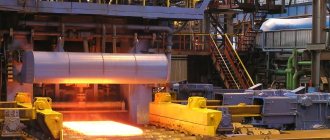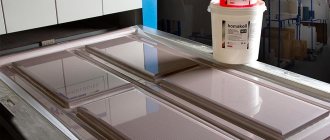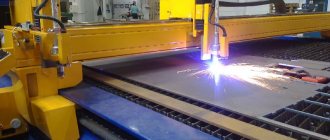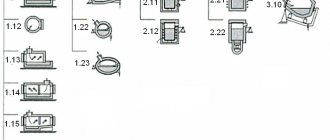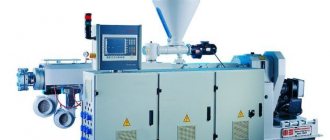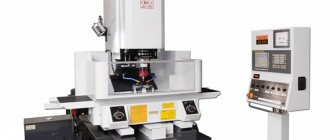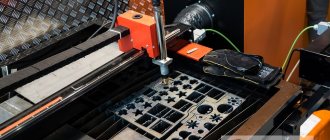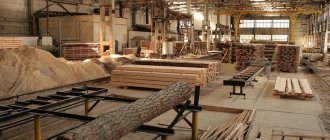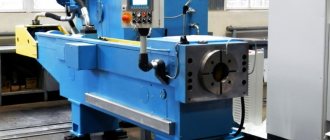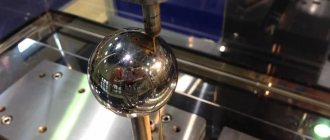Operating principle of a manual sheet bender
The sheet metal is placed on the work table and secured with a pressure beam (crossbeam). Then the rotary beam bends the workpiece to the desired angle. If necessary, the sheet is cut with a knife, which moves along guides along the length of the sheet bending machine.
Depending on the production tasks, the capabilities of the sheet bender can be expanded if you buy additional accessories: a folding machine, a support table, a protractor, a bending angle limiter, a cutting machine, etc.
Types of bending machines
Based on the type of drive, there are 3 types of sheet benders:
- Manual.
- Electromechanical.
- Hydraulic.
Manual equipment is operated by the operator. Such equipment is used in single or small-scale production. To increase bending force and increase accuracy, a pneumatic booster is provided. To increase accuracy, machines are often equipped with a foot pedal, which is pressed to raise and lower the bending beam.
Manual machines also include segment benders. The pivot and main beam consist of several segments that give shape to the finished product. If necessary, the equipment can be easily reconfigured to produce parts of a different configuration. Manual sheet benders:
- They can work with metal sheets or rolls up to 0.7-1.5 mm thick.
- Does not require a network connection.
- Can be installed on any hard, flat surface.
- Bends metal at an angle of up to 1350.
Segmental equipment is suitable for the production of products of complex shapes and parts with non-parallel bending lines. The main areas of application of the machines are hardware, roofing and metalworking workshops, mini-workshops.
Electromechanical equipment for bending metal is used in the serial production of products from sheet or coil products. An electric motor with a transmission mechanism is used as a drive.
Sheet benders:
- They have high performance.
- They work with rolled metal up to 4 mm thick.
- Suitable for the manufacture of large-sized parts and products.
Electromechanical equipment lends itself well to automation. The machines can be equipped with an automatic control unit with the ability to set and automatically correct bending angles and count finished products. Scope of application of the equipment: workshops and factories for the production of products from sheet and coil products.
Hydraulic machines are designed to work with thick rolled products up to 5 mm and mass production of large batches of products. A hydraulic pump with a cylinder allows you to develop a force of up to 30 tons or more, this ensures the high productivity of machine tools necessary for industrial production.
Equipment:
- Equipped with a CNC unit.
- Confidently works with massive workpieces of extreme thickness.
- Has high performance.
The main area of application is large manufacturing enterprises producing mass-produced products.
Plate bending machines may vary in design
- Pass-through sheet benders and machines with limited sheet feed;
Most sheet metal bending machines are designed with no feed restrictions, allowing you to work and cut large sheet sizes directly from the coil.
But there are models with limited sheet feeding, which have their own advantages: mobility (low weight) and more precise fixation of the sheet with a pressure beam along the entire length.
- Sheet bending machines with an all-metal pressure beam;
The most popular design of the pressure beam, which forms a separate element of the machine and is permanently attached to it.
- Sheet metal bending machines with segmental pressure beam (segmental);
If you buy sheet bending machines from our company in Moscow and throughout Russia, equipped with such a beam, this will allow you to produce boxes with several sides bent. Such segment bending machines for sheet metal can have a pressure beam, a bending table and a work table, which adds the possibility of using a sheet metal bender, but the price of such equipment is much higher than that of a manual sheet metal bending machine.
- Sheet benders with electric clamping of the pressure beam.
If you buy a sheet bending machine of this design, the clamping beam will be a replaceable element of the sheet metal bending machine and will be installed for a specific task, and the clamping will be carried out using an electromagnet.
When purchasing such a bending machine for sheet metal from our company in Moscow and throughout Russia, the kit includes several types and geometric shapes of clamping beams. This type of sheet metal bender has a large arsenal of possibilities for bending complex parts and has a higher price.
Techniques and tools used for bending metal strip parts
When choosing a hand tool for bending metal from a strip, it is necessary to take into account its properties and thickness, as well as the dimensions of the workpiece. In this case, the following recommendations are observed:
- If the thickness of the workpiece is less than 0.2 mm, it is advisable to use wooden or metal pads so that when struck with a hammer there are no marks left on them.
- When the workpiece thickness is from 0.2 to 0.5 mm, light hammers are used.
- To pre-bend metal sheets with a thickness of 3 mm or more, heavy hammers are used, and from 8 mm, sledgehammers are used.
- The weight of the vice is selected based on the forces applied for bending.
- When fixing workpieces in a vice, pads made of mild steel, non-ferrous metal, etc. are used.
To create the contour of the product profile, taking into account radii and angles of inclination, pliers are used. Bending is done along pre-designated lines. The angle of inclination is checked using a template.
Image #3: metal bending pliers
Manual sheet bending machines and mechanically driven devices are also used for processing sheet material. They have equipment for bending various profiles. The operating principle is based on the action of a rotary traverse, which, when moving, bends the workpiece at the required angle.
Image #4: Manual sheet metal bending machine
Advantages of Manual Sheet Metal Bending Machine
- low price;
You can buy a manual sheet bender in Moscow at a competitive price in the catalog of our company’s online store. The cost of a Russian-made manual sheet bender is significantly lower than that of electromechanical and bending machines.
- simple design;
Operating a sheet metal bending machine does not require special personnel training. Installation and configuration are easy.
- mobility;
If you buy a manual sheet bending machine in Moscow or have it delivered by Russian transport companies to any region of Russia, you can eliminate the problem of excess weight of the equipment (usually the weight of the equipment is up to 300 kg), compact dimensions and ease of assembly allow you to easily transport the bending machine across the territory carrying out work. This is very convenient, for example, when carrying out work directly on the roof of houses and in the field conditions of construction sites.
- The machines do not depend on power supply.
Sheet metal bending machines can be used in facilities where there is no electricity (for example, in buildings under construction).
Device of sheet bending machines
The design of a bending machine is not particularly complicated. The equipment consists of several main components:
- Racks or frames that perform a load-bearing function. In industrial machines for mass production and the manufacture of large parts, the load-bearing function is performed by a cast iron frame.
- Beams. The units are designed for fixing the workpiece and bending the metal. Working tools of the machine – segments – are also attached to the bending beam.
- Drive. The element is designed to develop the force necessary to bend metal. Sheet bending machines are equipped with a manual drive with a hydraulic or pneumatic booster, an electric motor, and a hydraulic system.
- Transmission mechanism. The unit is designed to transfer force from the drive to the bending beam.
Electric and hydraulic sheet bending machines are also equipped with a control unit for starting, stopping, and force regulation.
Types and design of bending machines
Bending of sheet metal is carried out using specialized equipment - sheet bending machines. According to the operating principle, metal bending machines can be divided into several types:
Universal bending machine
Universal. When this machine operates, the sheet is placed in a fixed matrix and, with the assistance of a punch, it is given the required shape. Punches are made in several designs, which differ from each other in shape and size, for example, in angle. As a rule, a groove in the shape of an angle is made on the matrix.
Universal presses are easily reconfigurable and can solve many technological problems.
Turning. This machine consists of a traverse, as the bending beam is called, a bending beam and a back stop. A clamping beam is necessary to secure the sheet of metal to the frame. The bending of the sheet is carried out by a bending beam. In fact, it is the main working element of this machine.
Rotary bending machine
Rotary bending machine
Rotary. The design of such equipment may include several shafts (rolls). They rotate around their axis. In addition, the work rolls can move in a vertical plane. A sheet of metal is placed in the space between the shafts and by moving them vertically the future bending radius is adjusted. After the sheet passes between the rotating shafts, it receives the required shape.
A metal bending machine can be powered by human muscle power, hydraulic, pneumatic, electric (electromechanical) or mechanical drive.
Folding machine
Folding machine
To work with metal of small thickness, folding or folding machines are used. They are widely used when working with roofing sheets, creating ventilation ducts, etc.
Metal bending and its main methods
Sheet bending
It should be understood that metal bending operations are not limited to working with sheet metal. When creating metal structures for various purposes, there is a need to use bent pipes or profiles.
Radius sheet bending
Radial bending of sheet metal is performed using the equipment described above. When performing it, it is important to choose the correct linear size of the workpiece. The designer must remember that the length of the workpiece should be slightly longer than the length of the finished part. This is due to the specifics of the bending operation. The fact is that when the position of one part of the sheet changes relative to another, the inner layers of the metal are compressed, and the outer ones are stretched. That is, before performing radius bending of metal, it is necessary to carefully calculate the geometric parameters of the workpiece.
To calculate the bending radius, it is enough to use tabular data that can be found in almost any engineering reference book.
